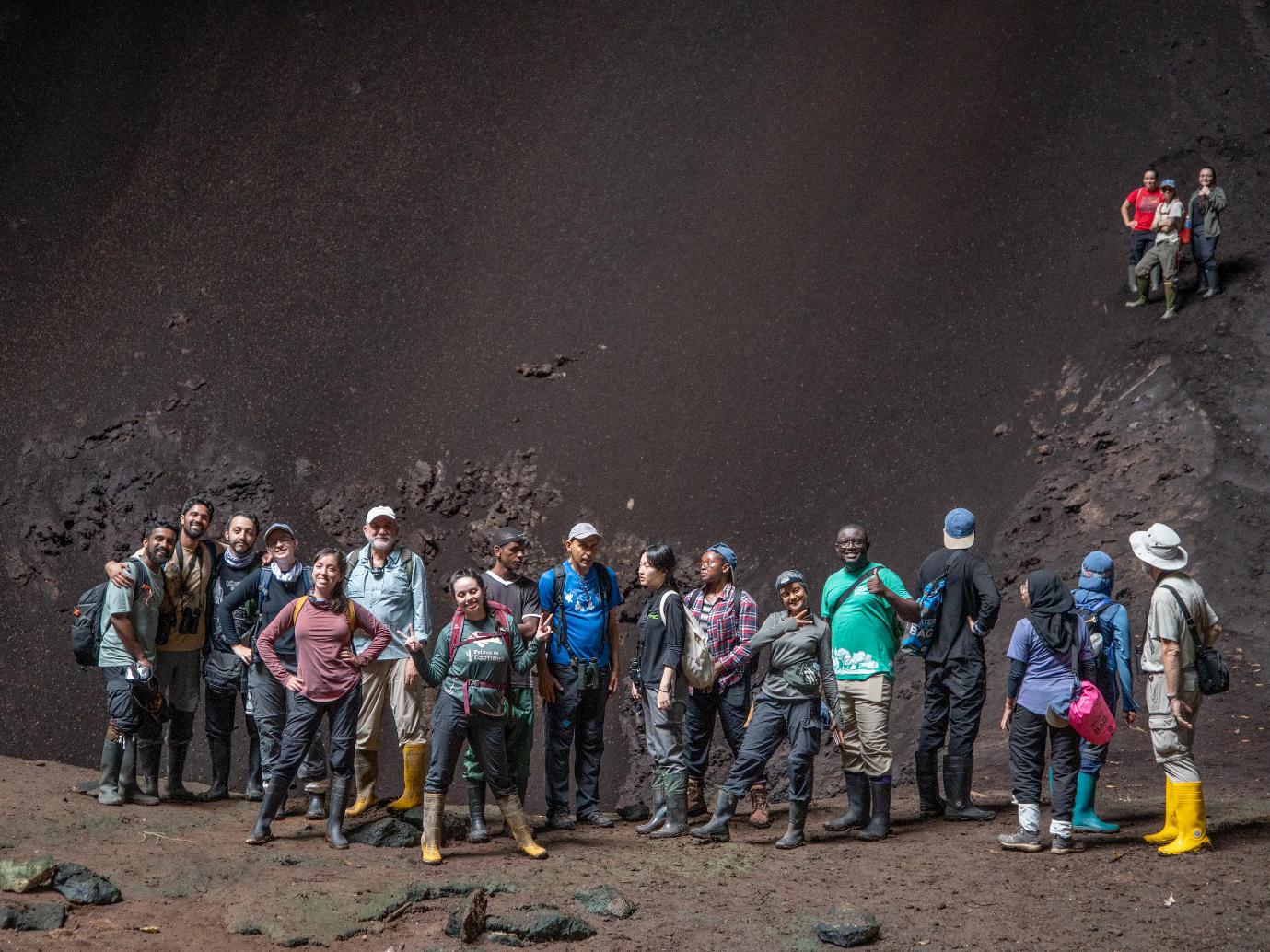Participants in the inaugural Global South Bats Workshop, which took place in Malyasia, gather during a research trip in Borneo's Gomantong Caves. Biological sciences faculty member Maria Sagot helped organize the multiday workshop.
Biological sciences faculty member Maria Sagot helped organize a first-of-its-kind workshop supporting important research across the Global South on an often-misunderstood yet ecologically vital animal.
In February 2025, the Global South Bats Workshop in Malaysia brought together faculty and students from 22 different countries to study bats’ behavior, ecological impact and challenges.
“The workshop focused on bat research, major conservation challenges and the development of collaborative projects to enhance capacity-building and conservation efforts in some of the world’s most critical biodiversity hotspots,” Sagot said.
The Global South houses more than 1,000 of the 1,426 known bat species, the workshop website noted: 20 percent of all classified mammal species in the world are bats, with 14 percent of bat species considered endangered by extinction.
The idea started around eight years ago from a need to better support and connect researchers in the Global South –- including Latin America, Africa, and Southern Asia –- studying the noteworthy flying mammal.
“Collaborations always seem to happen between the Global North and Global South, but we realized it’s important for researchers in the Global South to connect with each other,” Sagot explained. “We all study similar species and encounter similar problems, so it’s better to find ways to work together.”
Sagot, who is from Costa Rica, was happy to play a leadership role in organizing the first-of-its-kind workshop that brought together nine professors, around 20 students and a variety of support and event staff. National Geographic funded the workshop and the organization that put it together, as well as some seed money for projects.
For the first week on Malaysia’s Langkawi Island, during the mornings, faculty would share what they knew in topics such as bat behavior, convergent evolution, threats to bats and perceptions of the species, as well as techniques and goals. In the afternoons, they would set up nets and traps to capture and briefly study bats. Sagot was pleased to see researchers who barely knew each other from different continents working together in field activities, and that this represented the first time people from different regions of the Global South worked together in such an endeavor.
The second week moved the workshop to the Island of Borneo “to get people to collaborate and to create projects,” Sagot said. Examples of projects included studying the functions of whiskers on bats (“we don’t yet know the extent to which bats actually use them,” Sagot said), creating an open-source project showing location and status of cave roosts so bats can be better protected, and looking at how bats can benefit local farming operations.
“An example is working with coffee plantations, telling them about the importance of bats in eating pests, and the money they can save by working with bat colonies,” Sagot said. “In addition, these crops can be certified as organic by not using pesticides.”
Importance of bats
Sagot noted that for chiropterologists –- scientists who study bats –- a big challenge is overcoming misconceptions about these animals. Bats’ connections to vampires in pop culture and Hollywood depictions have not always been kind.
“People don’t understand the importance of bats to the ecosystem,” Sagot said. “The impact of bats either pollinating plants or killing pests is big.”
Agricultural industries that develop coffee, bananas, oranges, tequila and more rely heavily on bats for successful yields, Sagot said. A study in the Southern U.S. found an economic value of $20 million from bats toward cotton plantations, given the species’ proficiency at reducing pest populations. Closer to home, bats positively impact Upstate New York’s apple-growing industry.
“In the environment, bats are one of the main dispersers of pioneer plants in regrowing forests,” Sagot noted. “When forests are lost to fires or other threats, bats are the first ones to spread seeds so forests can regrow.”
But bats can help scientists in other ways. They are hardy animals, with some species able to live up to 40 years and resistant to many diseases.
“We can study why they can live so long without problems,” Sagot said. “They are resistant to some viruses and bacteria, and we’re studying their DNA to try to learn about their resistance and how this might benefit humans.”
Future plans
Sagot said organizers plan to do the workshop every other year, already assessing locations for 2027.
Between now and then, following up and keeping the projects that researchers started moving toward completion, as well as seeking funding sources for these projects, is the main concern. With many early-career scientists representing the next generation of chiropterologists involved, creating sustainable efforts is key.
Organizers are also looking to work with students on three different continents to support social media efforts to spread awareness of this work.
Whatever the future holds, Sagot and fellow organizers take pride in the work the inaugural workshop began.
“It was such a great experience to see a lot of people collaborating and working together, the first time where students from the entire Global South were brought together to collaborate,” Sagot said. “It was nice to see people from three different continents working together.”




